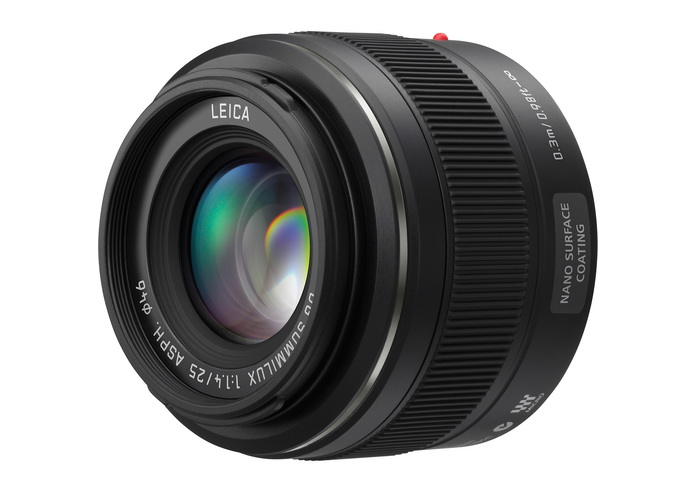 |
| Click to check price |
The Olympus E-M5 was used for this review.
For a better understanding of terms and methods used in this review, go here. The usual center, mid-section and corner crops are located at the very bottom of the page.
Introduction.
The Panasonic Leica 25mm F/1.4 lens (Made in Japan) is a compact lens, although not as small as I would expect for a micro 4/3 lens, meaning it’s almost as big as a typical full frame 50/1.4! The specs for this lens says there are two aspherical elements and one ‘UHR’ or ultra high refractive index element used in its construction, with a shot of ‘nano surface coatings’ thrown in for good measure; who knows if it’s really effective. Note; sometimes this lens makes clicking sounds like a rattlesnake, and would scare the crap out of people in the American Southwest if they were out on a hiking trail and didn’t know better. Panasonic touches very lightly on this in the troubleshooting section of the owner’s manual stating “when taking pictures; this is the sound of the lens or aperture movement; it is not a malfunction.” It does it even when not taking pictures, why is that?
For use on micro 4/3 mirrorless cameras only.
Fit and finish are very good. The lens is clad in plastic, with plastic filter threads, a wide rubber focus ring around the middle and a metal mount.
In the box: the lens, front and rear caps, a cinematic style hood, nylon pouch and owner’s manual.
Focusing. This lens auto-focuses almost silently. Focusing seems quite accurate at all distances, and reasonable quick in good light with the E-M5; other cameras may be different. The front filter ring doesn’t turn when focusing, so your polarizers and grads will work great.
Panasonic pays Leica Microsystems IR GmbH to use the name ‘Leica’ on its lenses, and Leica camera AG for using the ‘SUMMILUX’ name.
Product shots below courtesy of Panasonic.
Requisite product shots.
 |
| Panasonic MTF graph |
General information and specifications.
|
Lens
|
|
|
Box contents
|
Front and rear caps, nylon pouch and a plastic solid cinematic hood.
|
|
Cost
|
$499 retail as of 1/2013.
|
|
Build quality
|
Good.
|
|
Additional information
|
Sometimes makes weird rattlesnake type noise.
|
|
Specifications
|
|
|
Optical configuration
|
9 elements in 7 groups
|
|
Angle of view
|
47°
|
|
Aperture
|
7 blades, curved
|
| Formats |
Micro 4/3 only. With a crop factor of 2x the coverage equals 50mm in 135 film format.
|
|
Depth of field and focus scales?
|
Nothing.
|
|
Min. focus distance, image plane to subject @ max reproduction ratio
|
About 11.25″ (286mm)
|
|
Min. focus distance, end of lens barrel to subject @ max. reproduction ratio
|
About 8.1″ (206mm)
|
|
Hard stop at infinity focus?
|
No
|
|
Length changes when focusing?
|
No
|
|
Focus ring turns in AF?
|
No
|
|
Filter size
|
46mm
|
|
Filter ring rotates?
|
No
|
|
Distance encoder?
|
Yes
|
|
Max magnification
|
0.11x, or 0.22x (1:4.5) with crop factor.
|
|
Min. F/stop
|
F/16
|
|
Factory teleconverter compatible?
|
N/A
|
|
Length changes when zooming?
|
N/A
|
|
Dimensions WxL (my measurements)
|
2.5″ x 2.1″ 64mm x 54mm.
|
|
Maximum extended length (my measurements)
|
2.1″ (54mm)
|
|
Weight bare (my scale)
|
6.9oz (196g)
|
Optical qualities summary.
Lens flare/ghosting. Some large but dull ghosts appear when super bright light sources are close to, or inside the frame.
Color fringing (CA). Very good control along the sides of the image, but I see small to moderate amounts of axial type, which shows up as magenta tinges in high contrast areas at F/1.4-2.
Bokeh. Somewhat neutral at medium to longer focusing distances, and smooth at close focusing, see crops below.
Color. Neutral.
Close up filter. N/A.
Coma. Small amount at F/1.4, gone at F/2.
Regular filters N/A
Filter size is 46mm. This small filter size is fairly popular; with plenty of filter types available at good prices.
Distortion. Flat with distortion correction turned on. Check out the cropped samples below.
 |
| Corrected Jpeg, flat! |
 |
| Uncorrected from RAW file |
Distortion is strong in uncorrected RAW images, but looks flat with correction turned on.
Light fall-off.
|
F/1.4
|
F/1.4 uncorrected
|
|
|
|
|
F/2
|
F/2 uncorrected
|
|
|
|
Light fall-off is moderate when the aperture is wide open, but the sides brighten up significantly just one stop down.
Bokeh.
Bokeh in the center area looks decent at all apertures with the aperture shape showing up at F/2.8. I see some spherochromatism at F/1.4-2, which causes that particular aperture bokeh to appear less smooth than at other apertures. Spherochromatism shows itself as colored tinges around blurred highlights, such as when the foreground is blurred, you’ll get red outlined highlights, with the background blurred, you’ll get green outlined highlights, this goes away as you stop down, and is mostly noticeable on fast lenses when used wide open. In our case above, the green blends in nicely with the plant leaves, so it isn’t really noticeable in these crops. Bokeh along the sides of the frame is harsh at wide apertures, but that’s normal for this type of lens.
Let’s check out the close focus capabilities of this lens.
Check out the 100% cropped portion of the full image. The sample shot was taken with the Olympus E-5M 16mp camera, so don’t compare it to others that were taken with 12 or 24mp cameras. The subject is a standard US stamp, 0.87″x 1.0″ or 22mm x 25mm. Also, note the shot was taken as close to the subject as focusing allowed; in this case a fairly short 6″ (155mm), measured from the front of the lens barrel to the subject.
This lens has a small to medium reproduction ratio of 0.22x, (1:4.5), (in 135 format); and it produced a sharp close focus shot with good contrast at F/5.6, (F/4 about as good), stopping down to F/8 softens due to diffraction. As a side note; the “1996” on the bottom left of the stamp measures a mere 1mm wide.
 |
| As close as you can get. F/5.6, no larger image. |
Now for the conclusion.
If you’re looking for a 50mm equivalent prime lens for your micro 4/3 camera, look no further than the Panasonic 25mm F/1/4. This lens is somewhat pricey, but the optical quality easily makes it worth it!
Build quality is good, not great, however it does have a metal mount and feels solid in the hand. The wide focus ring makes manual focusing easy with the camera to your eye.
Other items worthy of mention are the lack of color fringing along the sides of the image, low to almost no distortion with correction turned on, and moderate light fall-off wide open, but falls to mild just one stop down. Coma is very well controlled, with only a tiny amount occurring at F/1.4 along the extreme sides. At F/2 it’s basically all gone, that’s excellent. (Coma is when points of light along the sides and corners of the image take on the shape of flying birds or odd polygons, usually equiangular).
Now for the great part about the Panasonic 25/1.4; the center sharpness is stunning, even at F/1.4!! The mid-sections sharpen up very well at F/4-5.6, with the corners staying a little soft when compared to the middle areas. The Panasonic Leica DG Summilux 25mm F/1.4 ASPH would make a great low-light hand-held lens for people wanting or needing this focal length. With the DOF of 25mm instead of 50mm, it’s even more practical for walk around applications in low-light at large apertures. With that said, I would recommend shooting at F/2-2.8 if possible as I see some axial color fringing around blown highlights at night, which is normal with all lenses this fast, but I thought I’d point it out anyways. Both axial (occurring all over) and lateral color fringing (along the sides) are removable in post processing using good photo editing programs like Lightroom 4 and PS etc.
|





































